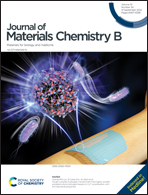pH-Responsive Au@Pd bimetallic core–shell nanorods for enhanced synergistic targeted photothermal-augmented nanocatalytic therapy in the second near-infrared window†
Abstract
Nanotheranostic agents based on plasmonic nanostructures with their resonance wavelengths located in the second near-infrared window (NIR-II) have gained significant attention in profound tumor photothermal therapy. However, the modulation of localized surface plasmon resonance of gold nanomaterials from the first near-infrared (NIR-I) window to the NIR-II window is still challenging. The structures and compositions of the plasmonic nanomaterials have demonstrated promising characteristics in controlling the optical properties of plasmonic nanostructures. Here, gold nanorod (Au NR) coated with an ultrathin palladium (Pd) shell was developed for tumor-targeted NIR-II photothermal-augmented nanocatalytic therapy through the combination of compositional manipulation and structural evolution strategies. These Au@Pd core–shell hybrid NRs (HNRs) were functionalized with biocompatible chitosan (CS) to acquire lower toxicity and higher stability in physiological systems. Further, Au@Pd–CS HNRs were endowed with an excellent targeting ability by conjugating with folic acid (FA). The as-synthesized Au@Pd–CS–FA HNRs show efficient and complete photothermal ablation of tumor cells upon 1064 nm laser irradiation. The remarkable photothermal conversion efficiency of 69.0% was achieved, which is superior to many reported photothermal agents activated in the NIR-II region. Excitingly, Au@Pd–CS–FA HNRs have peroxidase and catalase activities, simultaneously producing ˙OH for catalytic therapy and O2 for relieving tumor hypoxia and photodynamic therapy. Additionally, in vivo tumor photothermal therapy was carried out, where the biocompatible Au@Pd–CS–FA HNRs penetrate intensely into the tumor cells and consequently show remarkable therapeutic effects. The idea about plasmonic modulation behind the bimetallic core–shell nanostructure in this report can be extended to construct new classes of metal-based nanotheranostic agents with dual-modal combined therapy as an alternative to traditional chemotherapy.



 Please wait while we load your content...
Please wait while we load your content...